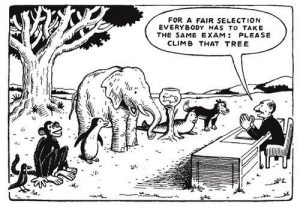
Children born to low-income families are more likely to be diagnosed with learning disabilities (Cortiella 2014). That means they are less likely to have access to services that would treat their learning disabilities, and their community would be less likely to have access to the services that would inform and reduce the stigma surrounding their disability . This puts this population at a high risk as students with learning disabilities are more likely to be held back in school, suffer from low self-esteem, and are at a higher risk of dropping out, depression, and drug use. Many critics argue that the overrepresentation of low-income and minority students in special education is often the result of racial bias and lowered expectations for youth in school systems across the United States (Boyd 2015).
Advocacy for children and adolescents with ADHD or any other learning disability is a key component in helping communities better understand, and treat these disorders. Creating new services, and optimizing existing ones could help families and schools in low-income communities better understand and address the issues related to learning disabilities among youth. When thousands of children fall into the cracks, or are the targets of discrimination by peers and teachers, investing more into understanding and treating learning disabilities could greatly improve the outcomes of thousands of students, and lower rates of dropouts, incarceration, and mental health issues (Cortiella 2014).
To continue treating learning disabilities as we do now is to continue letting a large number of people struggle without support, and at risk of higher negative outcomes . It’s important that programs are created that address the inequalities that exist in treatment and understanding of learning disabilities, especially as it applies to marginalized communities in the United States.
Not only are the diagnoses of learning disabilities higher, but the research shows that many children in low-income families are diagnosed with learning disabilities than their wealthier counterparts. Evidence suggests that racial biases in school administrators and teachers leads to diagnoses of learning disorders in students that may either not need them, or be misdiagnosed (Boyd 2015).
Being that children born to low-income families are more likely to suffer from some form of learning disability and less liable to receive actual services meant to treat the disability (Boyd 2015). This difficulty in accessing and affording appropriate services puts low-income families at a higher disadvantage in comparison to their wealthier counterparts. Considering that low-income families are less likely to report developmental concerns to a professional because of stigma and lack of access, it makes it much less likely that an appropriate intervention will occur within a school setting (DOH, 2016).
Because ‘learning disability’ is an umbrella term for any condition that causes difficulty in acquiring knowledge about an individual’s’ peer group, there are many conditions that fall under this label. The New York City Mayor’s Office for People with Disabilities (DOH 2016) has a page with a list of resources for parents and adults who are in need of various services, from evaluation to treatment of various learning disabilities. For example, there is a link to the “A.D.D. Resource Center,” (ADDRC 2016) which provides evaluation, coaching, and information for students seeking support for A.D.D. (ADDRC, 2015). Though this information is a good start, it is certainly not common knowledge, nor is the diagnostic process always that easy, as only one in five parents reported sharing their concerns with a professional (Doh 2016). It is all the harder for low-income families, for whom less than one in ten report voicing concerns to a professional.
This would accentuate the need for creating new services and optimizing ones that we currently have in order to help families and schools in low-income communities to better serve adolescents in their schools. As of right now the services that exist are usually hard to find, and exist in places that are too expensive and too far from the population that may need them.
Addressing this issue would mean taking advantage of the resources that already exist, and using the success of programs doing work to address these issues as models moving forward. The Department of Education provides funding for organizations that work within the field of mental health and youth (LD Advocates Guide 2012). Communities and individuals looking to direct services would do well to look to these organizations as examples.
Here in New York City, for example, there exist a few organizations that help to advocate for children diagnosed with learning disabilities or other mental health issues. Advocates for Children of New York, for example, has been providing legal services and protection for youth diagnosed with learning disabilities for decades (Advocates for Children of New York 2016). As an organization, they defend many minority and low-income youth who may face discrimination for their learning disabilities, or unfair treatment as a result of their diagnoses.
Providing low-cost or free legal representation for students could work as a huge first step towards helping families gain access to the services they need. It also helps set precedent for families and advocates working to challenge school districts or systems that may be operating unfairly targeting learning disabled or minority students.
Advocacy groups would also do well to tap into other existing services that can support youth and their families that have been diagnosed with a learning disorder. Understood.org has partnered with the National Center for Learning disabilities disseminating nationwide resrouces that youth and parents to self advocate, and become plugged into organizations that can provide support (NLCD Impact Update 2016).
The resources provided are crucial to empower individuals to understand the laws and systems that are at work within their own individual communities. It includes checklists for families to follow when talking with teachers about individualized education plans, as well as indispensible information about resources that exist. The website provides links to organizations and other programs that offer funding and support to individuals looking to advocate for their communities (NLCD Impact Update 2016).
These resources empower parents and youth to engage with their schools and communities to help curb the rising rates of diagnosis with the declining rate of funding for special education services for youth with learning disabilities. It helps them connect to the financial resources and support that already exists within the United States.
Being that many communities and populations are at greater risk of being diagnosed with learning disabilities, and receive fewer services, it is important to know where the resources are, and how to access them. Helping connect these communities to the resources should be a priority for advocates at this time, especially as the policies and services surrounding this issue stands to change within the next few years. In some places, like New York City, organizations exist that help connect these families to the resources they need. Other states and communities, however, may lack many of the organizations that may provide the legal resources that they need.

LD Advocates Guide. (2012, July). National Center for Learning Disabilities. Retrieved December 13, 2016, from http://ncld.convio.net/site/DocServer/ncldadvocatesguide.pdf?docID=245
Cortella, C. (n.d.). The State of Learning Disabilities: Facts Trends and Emerging Issues. Retrieved November 09, 2016.
Department of Education. . School Quality Guide 2013-2014 MS 223. Washington, DC: U.S. Government Printing Office. Retrieved September 20, 2015, from the World Wide Web:http://schools.nyc.gov/OA/SchoolReports/2013-14/School_Quality_Guide_2014_EMS_X223.pdf
Boyd, D., Lankford, J., Loeb, S., Rockooff, J., Wyckoff, J. (2008). The narrowing gap in New York City teacher qualifications and its implication for student achievement in high-property schools. The Journal of Policy Analysis and Management 27, 793-818.
Advocates for Children of New York | Home. (n.d.). Retrieved December 13, 2016, from http://advocatesforchildren.org/
Cortiella, C. (2014). The State of Learning Disabilities.
NCLD’s Impact Update (2016, November 8). Retrieved December 13, 2016, from http://www.ncld.org/archives/blog/nclds-impact-update-fall-2016












